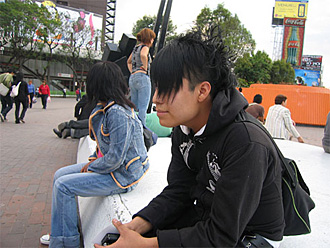
|
 |
 |
 Editorials | Issues | April 2008 Editorials | Issues | April 2008  
Subculture Clash Among Mexico Youth
 Chris Hawley - USA Today Chris Hawley - USA Today
go to original


| | Jose Luis Caballero, a 21-year-old self-described "Emo," hangs out in the Insurgentes Traffic Circle in Mexico City on April 7. Caballero said he has been threatened recently amid frictions between Mexico's multiplying youth movements. (Chris Hawley/USA Today) | | |
Mexico City — It is a Saturday at the Chopo flea market, and the angst-ridden youth of Mexico's blooming middle class have come to hang out.

Goths, skaters, punk rockers and "emos" mill around, checking out used albums and buying T-shirts.

The Chopo market is neutral ground. But in other parts of Mexico, a spate of attacks by punks and other groups on the emos has thrown a spotlight on the rapid growth of these "urban tribes" of disaffected, tech-savvy teens and young adults.

"Before, Mexico was very homogeneous," said Gerardo Reyes, one of the "darks," known as Goths in the USA. "Now the young people are splitting off, doing their own thing."

Mexico has seen youth movements before, when homegrown versions of hippies and punks popped up in the 1960s and '70s. In the past decade, the number of subgroups has soared, said Hector Castillo, a sociologist at the National Autonomous University of Mexico.

The phenomenon stems from Mexico's increasing access to music and fashion from other countries, people migrating toward cities, a strengthening economy and the nation's relative youth, he said. Nearly 60% of Mexicans are under age 30, compared with 42% of Americans, according to Mexico's census bureau.

The divisions among young people turned violent in March, when Internet posts and cellphone messages began appearing urging darks, punketos (punk rockers) and other groups to chase the emos from their hangout on the main plaza in the city of Querétaro.

Emo movement

Emo stands for emotional. Adherents listen to alternative music with sad lyrics, comb their hair over their eyes and wear tight T-shirts and sneakers. The movement came to Mexico from Europe and the USA about five years ago, Castillo said.

On March 7, hundreds of teens rushed the emos in the plaza, beating three of them. Television footage showed an emo pinned against a wall while the mob chanted, "He wants to cry! He wants to cry!" Police arrested 28 people.

A week later, riot police were called after punk rockers hurled bottles at a pro-emo protest at the Insurgentes Traffic Circle, an emo hangout in Mexico City. The tension subsided after a group of Hare Krishnas marched through the traffic circle, apparently unaware of what was going on.

Clashes spread to other cities in the central states of Querétaro, Jalisco and Guerrero. Videos of the fighting and anti-emo rants began appearing on YouTube.

"You'll be on the subway and hear someone say things like, 'Die, emo,' " said Jose Luis Caballero, 21. "It's pretty ugly."

Rosalia López, 18, an emo, said she and two friends were attacked by raperos, or rap music fans, last month outside a metro stop. They held a knife to her cheek but left after she began to cry.

The attacks led to peace marches and rallies, including one April 5 at the Insurgentes Traffic Circle.

The proliferation of youth cultures is tied to Mexico's strengthening economy, Castillo said.

Mexico's gross domestic product per capita rose to $8,190 in 2007, from $3,084 in 1997. Families are smaller: The average number of children per woman dropped 22% to 2.1 in the same decade.

Cultural connections

That means Mexican families — at least in the cities — have more disposable income to spend on clothes and technology. Those things help like-minded teens find each other and share music, gossip and fashion.

"The Internet, especially, is the switch or the door to open these connections, these new networks," Castillo said.

The percentage of Mexican homes with computers doubled to 22.1% last year from 11.8% in 2001. The percentage of Mexican homes with cable or satellite television also nearly doubled to 24.7% from 13.5% during the same period. Mexico has the 12th-highest number of cellphones in use in the world: 57 million.

Even as families become more affluent, home life has gotten more difficult for many young people, said Roberto Bermudez, another sociologist from National Autonomous University. Mexico's divorce rate has risen steadily to 12.3% in 2006, from 7.4% in 2000. "These groups are a middle-class phenomenon, but at the same time, many of these young people come from disintegrating families," he said.

At the Chopo market, Ruben Arias, 19, who described himself as an "anarcho-punk," said Mexican youth would probably continue to subdivide as the country becomes more technologically advanced and globalized.

He said media coverage fueled the anti-emo furor, and he predicted it would eventually subside.

"I'm not anti-emo," he said, shaking his 18-inch-high Mohawk. "People should have the freedom to do their own thing."

Hawley is Latin America correspondent for USA TODAY and The Arizona Republic. | 
 | |
 |



